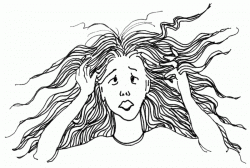No tricks: Those Greeks had a word for everything!
Q. When caught up in a truly "hairy" situation, whom might you want to search out? –A. Martin
A. An expert in "trichology," or "the study and treatment of hair and its disorders," says Anu Garg in The Dord, the Diglot, and an Avocado or Two. Of course, you wouldn't want to pull your hair out if you couldn't think of the word.
(However, if you did get such an urge, there's a word for that as well: "trichotillomania," from a Greek root meaning "father or mother of a teen.")
Just joking, assures Garg, but, "The Greeks were in fact the root cause of all this madness": "tricho"- (Greek for hair), "-ogy" (science, study), "tillein" (to pull out) and "-mania" (madness).
Q. According to the "rare Earth hypothesis," what makes the Earth so rare? –C. Sagan
A. It has taken more than four billion years of evolution on a quiet, stable planet orbiting a quiet, unusually stable star to provide the steady warmth our species and civilization require, says John Gribbin in 30-Second Theories.
Our giant neighbor Jupiter helps protect the Earth from cometary bombardment, vacuuming up these icy objects before they get to us. Even so, several major terrestrial catastrophes have occurred, including the extinction of the dinosaurs. Without Jupiter, it's doubtful that intelligent life would have had sufficient time to evolve on Earth.
Then there's Earth's large stabilizing moon, whose tidal forces help keep us warm and sustain the magnetic field shielding us from harmful cosmic rays. These same forces drive the ocean tides, instrumental in life migrating onto land. The moon is thought to be a chunk of Earth's crust knocked into orbit by an immense impact in the early days of the Solar System.
"That impact also thinned the Earth's crust, making plate tectonics possible, shifting the continents to and fro, allowing life on Earth to diversify in splendid isolation."
Q. How have "looking time" experiments with dogs revealed yet another facet of canine intelligence? –C. Stuart
A. A dog can tell another dog's size simply by hearing it growl, according to Hungarian ethologist Peter Pongracz and colleagues, says Science magazine. When researchers showed 24 test canine subjects images of other dogs and then accompanied these with recordings of food-guarding dog growls, 20 of the subjects (more than 80 percent) looked first and longer at those images where the pictured dog sizes matched those of the growls.
"Matching a sound to a photograph is a complex cognitive talent previously seen only in primates," noted the scientists.
Similar sorts of "looking time" experiments help in mapping out infants' cognitive capabilities long before linguistic clues kick in to aid the researchers. In either case, a doggone clever way of doing research!
Q. While most human senses are concentrated in the head, what rhyming exclave of the main sense organs was discovered recently at the University of Maryland? a) The Eye in your Thigh: a patch of skin cells on the leg able to distinguish between bright and dark conditions, perhaps to help regulate the body clock; b) The Ear in your Rear: nerves in the buttocks attuned to infrasound vibrations of 10-25 hertz, which may warn of approaching predators or thunderstorms; c) The Nose in your Toes: scent-detecting sebaceous glands on the feet, purpose unclear; d) The Tongue in your Lung: taste-bud-like receptors that detect bitter substances and dilate or restrict the airways accordingly. –M. Jagger
A. Did you correctly choose "d" (from New Scientist magazine)?
~
Send Strange questions to brothers Bill and Rich at [email protected]
